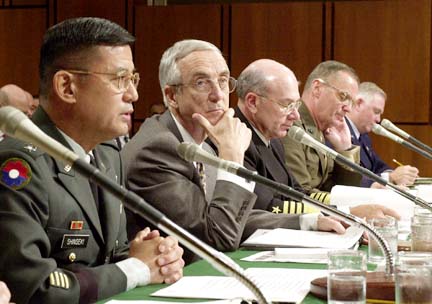

Isle brigade joins The 25th Infantry Division (Light) at Schofield Barracks was chosen today to be a key part of the Army's new transformation plan for a fast-attack force designed to respond to military operations ranging from small scale skirmishes such as in Bosnia and Kosovo to war.
Army’s fast-attack
battle plan
A light armored force prepared
for Pacific hot spots is charted
for Schofield BarracksBy Gregg K. Kakesako
gkakesako@starbulletin.comThe Army announced that 25th Division's 2nd Warrior Brigade at Schofield Barracks and the 172nd Infantry Brigade (Separate) at Forts Wainwright and Richardson in Alaska -- both elements of U.S. Army Pacific -- will be the next locations of its four Interim Brigade Combat Teams. The new brigades will be stationed in Alaska and Hawaii so they could be deployed as rapidly as possible to Pacific region hot spots.
The new units will be equipped with new 19-ton General Motors-built eight-wheeled light armored vehicle.

The news of the creation of the fast-attack combat unit for Hawaii's "Tropic Lightning" soldiers was hailed by U.S. Sen. Daniel Inouye, a World War II Medal of Honor recipient. "Throughout my service in Congress I have advocated for a strong military and emphasized Hawaii's Pacific location as an indispensable part of America's defense."The Hawaii Democrat said the Army's action reflects "the 25th Infantry Division's present and future importance in the protection of our nation and our interests."
Inouye said the change will mean Hawaii "will continue to play a key role in the strategic training and deployment of our armed forces."
Lt. Gen. Ed Smith, U.S. Army Pacific commander, added that the proposal shows "our senior Army leaders emphasis in Alaska and Hawaii, in terms of strategic locations, training opportunities and supportive communities at home stations."
In Alaska, Sen. Ted Stevens said the designation could mean new buildings, ranges, training exercises, motor pools and housing at the two installations.
The other two brigades are the 2nd Armored Cavalry Regiment (Light) at Fort Polk, La.; and the 56th Brigade of the 28th Infantry Division (Mechanized) of the Pennsylvania Army National Guard.
The changes are dependent upon an environmental impact statement that is scheduled to be completed this fall. Among other things the review will consider the environmental consequences of changes in the number of vehicles and personnel in Alaska and Hawaii.
The Interim Brigade Combat Teams are the brainchild of Army Chief of Staff Gen. Eric Shinseki and reflect the changing role of the Army and the need to respond to skirmishes throughout the globe.
The four-star general, who fought with the armored cavalry in Vietnam and commanded U.S. peacekeeping troops in Bosnia, has said the Army currently is not lean enough to respond to short-notice crises and smaller-scale conflicts.
Its heavy forces, which employ Abrams tanks, are unequaled in the world today but are difficult to insert in distant theaters with no prepared entry points, such as ports or airfields.
Critics are concerned that the creation of the interim brigades could lead to abandonment of Abrams tanks.
The change also comes when the 25th Division has come under fire for use of Makua Valley as a live-fire training range. Environmentalists and Hawaiian activists want the Army out of the 4,000-acre Waianae Coast valley. They have filed federal lawsuits arguing that continual use of the valley will strip it of endangered plants and animals.
The interim light brigade concept has been tested for the past year at Fort Lewis in the state of Washington, where two brigades there have been equipped with wheeled armored vehicles, capable of carrying soldiers into combat.
Before taking command of the 25th Infantry Division, Maj. Gen. James Dubik spearheaded the test for the Army's transformation program to identify necessary changes in doctrine, organization, equipment, training and leadership development.
With 3,500 to 4,000 soldiers, the mobile brigade also is supposed to have increased intelligence-gathering capabilities. It will be reorganized and equipped with medium armored gun systems, infantry and mortar.
Army companies and battalions are organized as pure tank or infantry units and then reconfigured to meet individual mission requirements before being sent into combat.
In November, the Army awarded General Motors a $4 billion contract to build 2,131 of a new family of wheeled armored vehicles.
The light armored vehicle will have a maximum speed of 60 mph and be able to travel 300 miles on one tank of fuel.
It will be the first ground combat vehicle the Army has built since the Bradley Infantry Fighting Vehicle in 1980.
It costs about $1 billion to form one of the units.
The Army is restructuring units as fast-response force: New unit
Where: 25th Division (Hawaii), 172nd Brigade (Alaska), 2nd Armored Cavalry Regiment (Louisiana), 56th Brigade (Pennsylvania)
Ready to fight: Within 96 hours
Equipment: New eight-wheeled light armored vehicles
Make up: Three infantry, one artillery and one reconnaissance battalion